technical data MERCEDES-BENZ SLC 2017 Owners Manual
[x] Cancel search | Manufacturer: MERCEDES-BENZ, Model Year: 2017, Model line: SLC, Model: MERCEDES-BENZ SLC 2017Pages: 294, PDF Size: 9.12 MB
Page 8 of 294
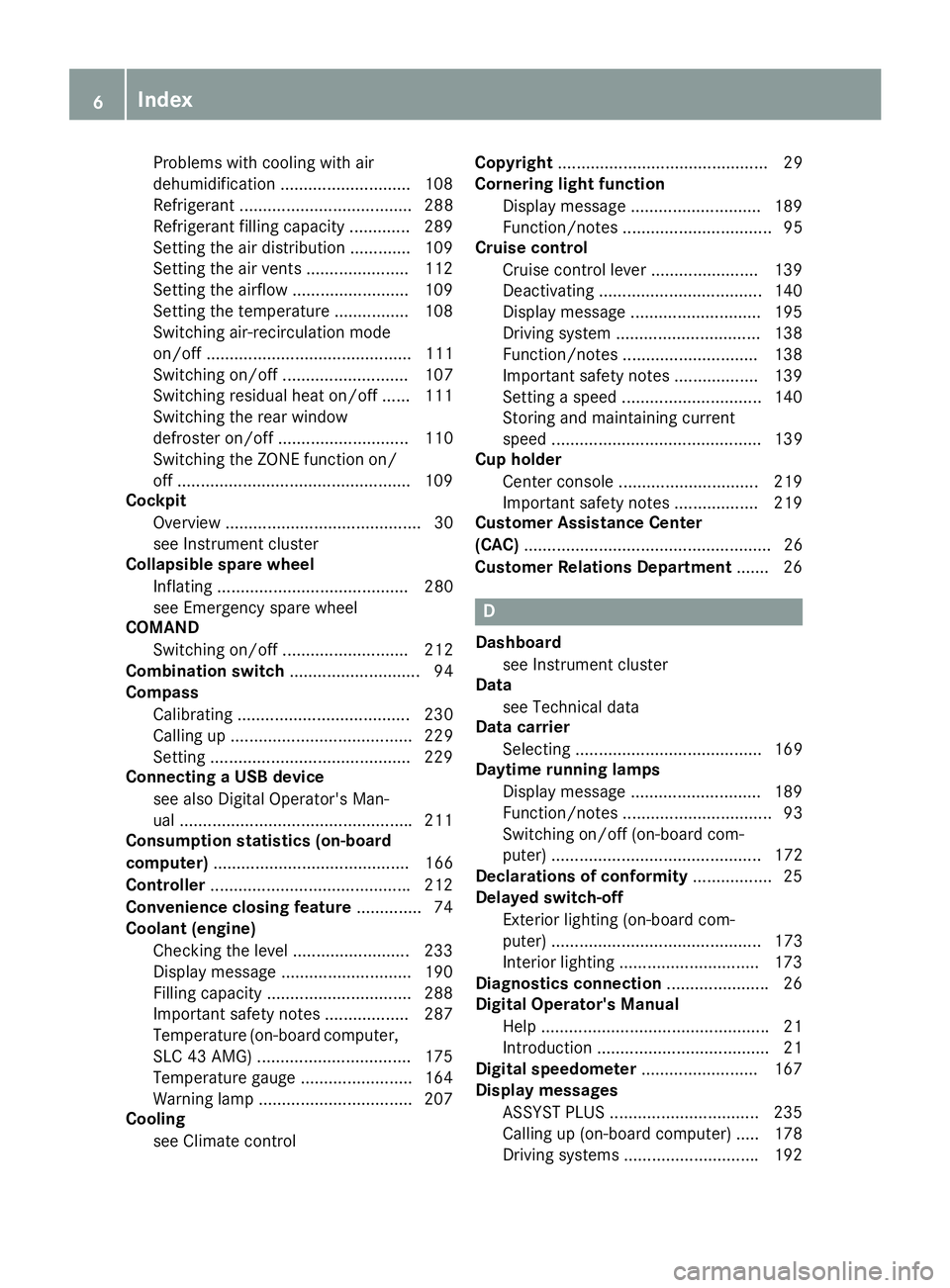
Problems with cooling with air
dehumidification ........................... .1 08
Refrigerant ..................................... 288
Refrigerant filling capacity ............. 289
Setting the ai rd istribution ............. 109
Setting the ai rv ents ..................... .1 12
Setting the airflow ......................... 109
Setting the temperature ................ 108
Switching air-recirculation mode
on/off ............................................ 111
Switching on/off ........................... 107
Switching residua lh ea to n/off ...... 111
Switching the rear window
defroster on/off ............................ 110
Switching the ZONE function on/
off ................................................. .1 09
Cockpit
Overview .......................................... 30
see Instrument cluster
Collapsibl es pare wheel
Inflating ......................................... 280
see Emergency spare wheel
COMAND
Switching on/off ........................... 212
Combination switch ............................ 94
Compass
Calibrating ..................................... 230
Calling up ....................................... 229
Setting .......................................... .2 29
Connectin gaU SB device
see also Digita lO perator's Man-
ua l. ................................................ .2 11
Consumptio ns tatistic s( on -board
computer) .......................................... 166
Controller .......................................... .2 12
Convenience closing feature .............. 74
Coolan t( en gine)
Checking the leve l. ........................ 233
Display message ............................ 190
Filling capacity ............................... 288
Important safety notes .................. 287
Temperature (on-board computer,
SLC 43 AMG) ............................... 175
Temperature gauge ........................ 164
Warning lamp ................................. 207
Cooling
see Climate control Copyright ............................................. 29
Cornerin gl ight function
Display messa ge ............................ 189
Fu ncti
on/notes ................................ 95
Cruis ec on trol
Cruise control leve r. ...................... 139
Deactivating ................................... 140
Display message ............................ 195
Driving system ............................... 138
Function/notes ............................ .1 38
Important safety notes .................. 139
Setting as pee d. ............................. 140
Storing and maintaining current
spee d. ............................................ 139
Cup holder
Center console .............................. 219
Important safety notes .................. 219
Customer Assistanc eC en ter
(CAC) ..................................................... 26
Customer Relations Department ....... 26
D Dashboard
see Instrument cluster
Data
see Technical data
Data carrier
Selecting ........................................ 169
Daytime runnin gl amps
Display message ............................ 189
Function/notes ................................ 93
Switching on/off (on-board com-
puter) ............................................. 172
Declarations of conformity ................. 25
Delaye ds witch-off
Exterior lighting (on-board com-
puter) ............................................. 173
Interior lighting .............................. 173
Diagnostic sc on nection ..................... .2 6
Digital Operator's Manua l
Help ................................................ .2 1
Introduction .................................... .2 1
Digital speedomete r ........................ .1 67
Display messages
ASSYST PLUS ................................ 235
Calling up (on-board computer) ..... 178
Driving systems ............................ .1 926
Index
..
Page 10 of 294

Hydroplaning ................................. 138
Icy roa ds urface s. .......................... 138
Limited braking efficiency on sal-
ted roads ....................................... 137
Snow chains .................................. 257
Subjecting brakes to al oa d. .......... 136
Wet roa ds urface ........................... 136
DVD video
Operating (on-board computer) ..... 169
see also Digital Operator's Man-
ua l. ................................................. 211
DYNAMI CS ELEC Tb utton .................. 121
EEASY-ENTRY feature
Activating/deactivating ................. 174
Function/notes ................................ 87
EASY-EXI Tf eature
Crash-responsive ............................. 88
Function/notes ................................ 87
Switching on/off ........................... 174
EBD (electronic brake forc ed istri-
bution)
Displa ym essag e. ........................... 181
Function/note s. ............................... 61
EC Od isplay
Function/note s. ............................ 134
On-board compute r. ...................... 166
EC Os tart/sto pf unction
Automati ce ngine start .................. 118
Automati ce ngine switch-off .......... 118
Deactivating/activating ................. 119
Genera li nformation ....................... 118
Important safety notes .................. 118
Introduction ................................... 118
Electronic Stability Program
see ESP ®
(Electronic Stability Program)
Emergency
Automati cm easures afte rana cci-
dent ................................................. 51
Emergenc yr elease
Driver's doo r. ................................... 70
Trunk ............................................... 72
Vehicl e. ............................................ 70
Emergenc ys pare wheel
Genera ln otes ................................ 280
Important safety notes .................. 279 Removing ....................................... 280
Storage location ............................ 280
Stowing .......................................... 280
Technical data ............................... 280
Emergenc yT ensionin gD ev ices
Activation ......................................... 48
Emission sc on trol
Service and warranty information .... 23
Engine
Check Engine warning lamp ........... 207
Displa ym essage ............................ 190
ECO start/stop function ................ 118
Engine number ............................... 284
Irregula rr unning ............................ 120
Jump-starting ................................. 249
Starting problems .......................... 120
Starting the engine with the
SmartKey ....................................... 117
Starting with KEYLESS-GO ............. 117
Switching off .................................. 131
Tow-starting (vehicle ). .................... 253
Engine electronics
Note s. ............................................ 282
Problem (malfunction) ................... 120
Engine oil
Adding ........................................... 232
Additi ves ........................................ 287
C h ecking the oi ll ev el ..................... 232
Checking the oi ll ev el using the
dipstick .......................................... 232
Displa ym essage ............................ 191
Filling capacity ............................... 287
Genera ln otes ................................ 286
Note sa bout oi lg rade s. .................. 286
Note sono il level/consumption .... 232
Temperature (on-board computer,
SLC 43 AMG ). .............................. 175
Entering an address
see also Digital Operator's Man-
ua l. ................................................. 211
ESP ®
(Electroni cS tability Pro-
gram)
AMG menu (on-board computer) ... 175
Characteristics ................................. 58
Deactivating/activating (except
SLC 43 AMG ). ................................ 59
Deactivating/activating (SLC 43
AMG ). .............................................. 608
Index
..
..
Page 11 of 294

Display message ............................ 179
Function/note s. ............................... 58
Genera ln otes .................................. 58
Important safety information ........... 58
Warning lamp ................................. 205
ETS/4ETS (Electroni cT raction Sys-
tem) ...................................................... 58
Exhaus tc heck ................................... 134
Exhaus tp ipe (cleaning instruc-
tions) .................................................. 240
Exterior lighting
Setting options ................................ 93
see Lights
Exterior mirrors
Adjusting ......................................... 88
Dipping (automatic) ......................... 90
Folding in when locking (on-board
computer) ...................................... 174
Folding in/out (automatically ). ........ 89
Folding in/out (electrically) ............. 89
Ou tofp osition (troubleshooting ). .... 89
Storing settings (memory func-
tion) ................................................. 91
Storing the parking position ............. 90
Eyeglasse sc om partment ................. 218
F
Favorites
Overview ........................................ 213
Filler cap
see Refueling
Fillin gc apacitie s( Technical data) ... 284
Flat tire
MOExtended tire s. ......................... 242
Preparing the vehicl e. .................... 241
TIREFIT kit ...................................... 243
see Emergency spare wheel
Floormats ........................................... 230
Frequencies
Mobil ep hone ................................. 282
Two-way radio ................................ 282
Fuel
Additives ........................................ 286
Consumption statistics .................. 166
Displaying the current consump-
tion ................................................ 166
Displaying the rang e. ..................... 166 Driving tip s. ................................... 134
Fue lg auge ....................................... 31
Grade (gasoline ). ........................... 285
Important safety notes .................. 285
Problem (malfunction) ................... 131
Refueling ........................................ 129
Tank content/reserve fue l. ............ 285
Fue lf ille rf lap
Opening ......................................... 130
Fue ll evel
Calling up the rang e( on -board
computer) ...................................... 166
Fue lt ank
Capacity ........................................ 285
Problem (malfunction) ................... 131
Fus ea llocatio nc hart (vehicl et ool
kit) ...................................................... 241
Fuses
Allocation chart ............................. 253
Before changing ............................. 254
Fus eb ox in the engine compart-
ment .............................................. 254
Fus eb ox in the trunk ..................... 254
Important safety notes .................. 253
G
Garag ed oo ro pener
Clearing the memory ..................... 228
Genera ln otes ................................ 226
Important safety notes .................. 226
Opening/closing the garag ed oo r. .2 28
Problems whe np rogramming ....... .2 28
Programming (button in the rear-
view mirror) ................................... 226
Synchronizing the rolling code ....... 227
Gear indicator (on-board com-
puter, SLC 43 AMG) ........................ 175
Genuine parts ...................................... 22
Glove box .......................................... .2 17
Google ™L oc al Search
see also Digita lO perator's Man-
ua l. ................................................ .2 11
H
Handbrake
see Parking brake Index 9
..
Page 18 of 294
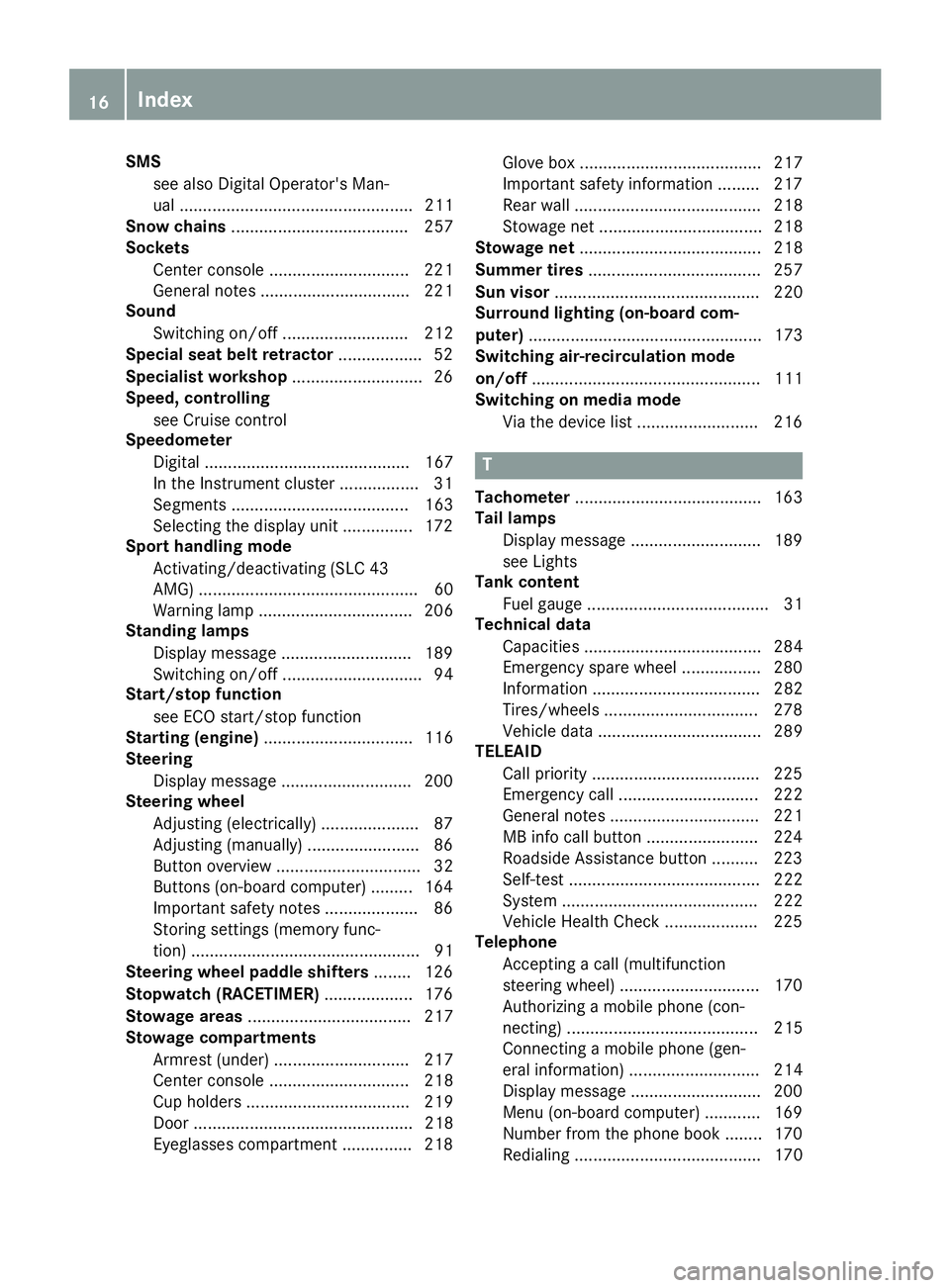
SMS
see also Digital Operator's Man-
ual .................................................. 211
Snow chains ...................................... 257
Sockets
Center console .............................. 221
General notes ................................ 221
Sound
Switchin go n/off ........................... 212
Special seat belt retractor .................. 52
Specialist workshop ........................... .2 6
Speed, controlling
see Cruise control
Speedometer
Digital ............................................ 167
In the Instrument cluster ................. 31
Segment s. ..................................... 163
Selectin gt he display unit ............... 172
Sport handling mode
Activating/deactivating (SLC 43
AMG) ............................................... 60
Warning lamp ................................. 206
Standing lamps
Display message ........................... .1 89
Switching on/off .............................. 94
Start/stop function
see ECO start/stop function
Starting (engine) ................................ 116
Steering
Display message ............................ 200
Steering wheel
Adjusting (electrically ). .................... 87
Adjusting (manually ). ....................... 86
Butto no verview ............................... 32
Buttons (on-board computer) ......... 164
Important safety notes .................... 86
Storing settings (memory func-
tion) ................................................. 91
Steering whee lp addle shifters ........ 126
Stopwatch (RACETIMER) ................... 176
Stowag ea reas ................................... 217
Stowag ec om partments
Armrest (under ). ............................ 217
Center console .............................. 218
Cu ph olders ................................... 219
Door ............................................... 218
Eyeglasses compartment ............... 218 Glove box ....................................... 217
Important safety information ......... 217
Rear wal l ........................................ 218
Sto
wag en et ................................... 218
Stowag en et ....................................... 218
Summe rt ires ..................................... 257
Sun visor ............................................ 220
Surround lighting (on-board com-
puter) .................................................. 173
Switchin ga ir-recirculatio nm ode
on/off ................................................. 111
Switchin gonm edi am ode
Via the device list .......................... 216
T Tachometer ........................................ 163
Tail lamps
Displa ym essage ............................ 189
see Lights
Tank content
Fue lg auge ....................................... 31
Technical data
Capacities ...................................... 284
Emergency spare whee l. ................ 280
Information .................................... 282
Tires/wheels ................................. 278
Vehicl ed at a. .................................. 289
TELEAID
Call priority .................................... 225
Emergency cal l. ............................. 222
Genera ln otes ................................ 221
MB info cal lb ut ton ........................ 224
Roadsid eA ssistance button .......... 223
Self-test ......................................... 222
System .......................................... 222
Vehicl eH ealth Check .................... 225
Telephone
Accepting ac al l( multifunction
steering wheel) .............................. 170
Authorizing am obil ep hone (con-
necting) ......................................... 215
Connecting am obil ep hone (gen-
era li nformation) ............................ 214
Displa ym essage ............................ 200
Menu (on-board computer) ............ 169
Numbe rf rom the phone boo k. ....... 170
Redialing ........................................ 17016
Index
Page 29 of 294

The following text is published as required of
manufacturers under Title 49, Code of U.S. Fed-
eral Regulations, Part 575 pursuant to the
"National Traffic and Motor Vehicle Safety Act of
1966".
If you believe that your vehicle has ad efect
which could cause ac rash or could cause injury
or death, you should immediately inform the
National Highway Traffic Safety Administration
(NHTSA )ina ddition to notifying Mercedes-Benz
USA ,L LC.
If NHTSA receives similar complaints ,itm ay
open an investigation, and if it finds that as afety
defect exists in ag roup of vehicles, it may order
ar ecall and remedy campaign. However, NHTSA
cannot become involved in individual problems
between you, your dealer, or Mercedes-Benz
USA ,L LC.
To contact NHTSA ,y ou may call the Vehicle
Safety Hotlin et oll-free at
1-888-327-4236(TTY: 1-800-424-9153 ); go to
http://www.safercar.gov ;orw rite to: Admin-
istrator ,N HTSA ,4 00 Sevent hS treet, SW.,
Washington ,DC2 0590.
You can also obtain other information about
motor vehicle safety from
http://www.safercar.gov
Limited Warranty
! Follow the instructions in this manual about
the proper operation of your vehicle as well as
about possible vehicle damage. Damage to
your vehicle that arises from culpable contra-
ventions against these instructions is not cov-
ered either by the Mercedes-Benz Limited
Warranty or by the New or Used-Vehicle War-
ranty.
QR codes for the rescue card
The QR codes are secured in the fuel filler flap
and on the opposite side on the B-pillar. In the
event of an accident ,r escue services can use
the QR code to quickly find the appropriate res-
cue card for your vehicle. The current rescue
card contains the most important information
about your vehicle in ac ompact form, e.g. the
routing of the electric cables.
You can find more information under http://
portal.aftersales.i.daimler.com/public/ content/asportal/en/communication/
informationen_fuer/QRCode.html.
Data stored in the vehicle
Data storage Aw ide range of electronic components in your
vehicle contain data memories.
These data memories temporarily or perma-
nently store technical information about: R
vehicle's operating state R
incidents R
malfunctions
In general, this technical information docu-
ment st he state of ac omponent, am odule, a
system or the surroundings.
These include, for example: R
operating conditions of system components,
e.g. fluid levels R
the vehicle's status messages and those of its
individual components, e.g. number of wheel
revolutions/speed, deceleration in move-
ment ,l ateral acceleration, accelerator pedal
position R
malfunction sa nd defects in important system
components, e.g. lights, brakes R
vehicle reaction sa nd operating conditions in
special driving situations, e.g. air bag deploy-
ment ,i ntervention of stability control sys-
tems R
ambient conditions, e.g. outside temperature
This data is of an exclusively technical nature
and can be used to: R
assist in recognizing and rectifying malfunc-
tions and defects R
analyze vehicle functions, e.g. after an acci-
dent R
optimize vehicle function
The data cannot be used to trace the vehicle's
movements.
When your vehicle is serviced, technical infor-
mation can be read from the event data memory
and malfunction data memory.
Services include, for example: R
repair services R
service processes R
warranties R
quality assuranceData stored in the vehicle 27
Introduction Z
Page 30 of 294
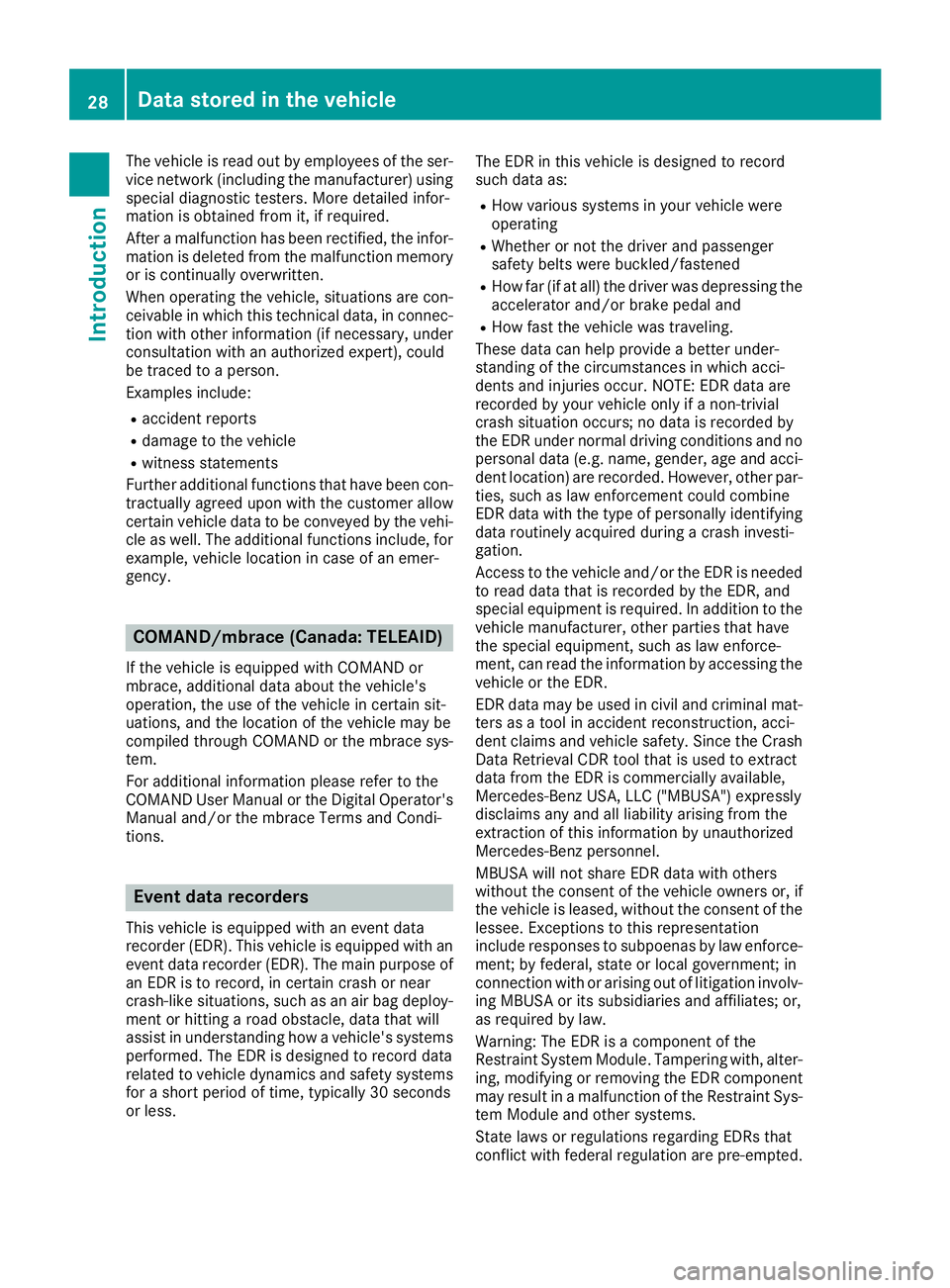
The vehicle is read out by employees of the ser-
vice network (including the manufacturer) using
special diagnostic testers. More detailed infor-
mation is obtained from it, if required.
After am alfunction has been rectified, the infor-
mation is deleted from the malfunction memory
or is continually overwritten.
When operating the vehicle, situations are con-
ceivable in which this technical data, in connec-
tion with other information (if necessary, under
consultation with an authorized expert), could
be traced to ap erson.
Examples include: R
accident reports R
damage to the vehicle R
witness statements
Further additional functions that have been con-
tractually agreed upon with the customer allow
certain vehicle data to be conveyed by the vehi-
cle as well. The additional functions include, for
example, vehicle location in case of an emer-
gency.
COMAND/mbrace (Canada: TELEAID) If the vehicle is equipped with COMAND or
mbrace, additional data about the vehicle's
operation, the use of the vehicle in certain sit-
uations, and the location of the vehicle may be
compiled through COMAND or the mbrace sys-
tem.
For additional information please refer to the
COMAND User Manual or the Digital Operator's
Manual and/or the mbrace Terms and Condi-
tions.
Event dat ar ecordersThis vehicle is equipped with an event data
recorder (EDR). This vehicle is equipped with an
event data recorder (EDR). The main purpose of
an ED Ristor ecord, in certain crash or near
crash-lik es ituations, such as an air bag deploy-
ment or hittin gar oad obstacle, data that will
assist in understanding how av ehicle's systems
performed. The ED Risd esigned to record data
related to vehicle dynamics and safety systems
for as hort period of time, typically 30 seconds
or less. The ED Rint his vehicle is designed to record
such data as: R
How various systems in your vehicle were
operating R
Whether or not the driver and passenger
safety belts were buckled/fastened R
How far (if at all) the driver was depressing the
accelerator and/or brake pedal and R
How fast the vehicle was traveling.
These data can help provide ab etter under-
standin goft he circumstances in which acci-
dents and injuries occur. NOTE: ED Rd ata are
recorded by your vehicle only if an on-trivial
crash situation occurs; no data is recorded by
the ED Ru nder normal driving conditions and no
personal data (e.g. name, gender, age and acci-
dent location) are recorded. However, other par-
ties, such as law enforcement could combine
ED Rd ata with the type of personally identifying
data routinely acquired during ac rash investi-
gation.
Access to the vehicle and/or the ED Risn eeded
to read data that is recorded by the EDR, and
special equipment is required. In addition to the
vehicle manufacturer, other parties that have
the special equipment, such as law enforce-
ment ,c an read the information by accessing the
vehicle or the EDR.
ED Rd ata may be used in civil and criminal mat-
ters as at ool in accident reconstruction, acci-
dent claims and vehicle safety. Sinc et he Crash
Data Retrieval CDR tool that is used to extract
data from the ED Risc ommercially available,
Mercedes-Benz USA ,L LC ("MBUSA") expressly
disclaims any and all liability arising from the
extraction of this information by unauthorized
Mercedes-Benz personnel.
MBUSA will not share ED Rd ata with others
without the consen toft he vehicle owners or, if
t he vehicle is leased, without the consen toft he
lessee. Exceptions to this representation
include responses to subpoenas by law enforce-
ment ;byf ederal, state or local government; in
connection with or arising out of litigation involv-
ing MBUSA or its subsidiaries and affiliates; or,
as required by law.
Warning: The ED Risac omponent of the
Restraint System Module. Tampering with, alter-
ing, modifying or removing the ED Rc omponent
may result in am alfunction of the Restraint Sys-
tem Module and other systems.
Stat el aws or regulations regarding EDRs that
conflict with federal regulation are pre-empted.28
Data stored in the vehicle
Introduction
Page 51 of 294

deployed air bags replaced and faulty air bags
repaired. This will help to make sure the air bags
continue to perfor mt heir protective function for
the vehicle occupants in the event of ac rash.
G WARNING
Emergenc yT ensioning Devices that have
deployed pyrotechnically are no longer opera-
tional and are unable to perfor mt heir inten-
ded protective function .T his poses an
increased risk of injury or even fatal injury.
Have pyrotechnically triggered Emergency
Tensioning Devices replaced immediately at a
qualified specialist workshop.
An electric moto risu sed by PRE-SAFE ®
to trig-
ger the tightenin goft he seat belt in hazardous
situations. This procedure is reversible.
If Emergenc yT ensioning Devices are triggered
or air bags are deployed, you will hear ab ang,
and as mall amount of powder may also be
released. The �u restraint system warning
lamp lights up.
Only in rare cases will the bang affect your hear-
ing. The powder that is released generally does
not constitute ah ealth hazard, but it may cause
short-term breathin gd ifficulties in people with
asthma or other respiratory problems. Provided
it is safe to do so, you should leave the vehicle
immediately or open the window in order to pre-
vent breathin gd ifficulties.
Air bags and pyrotechnic Emergenc yT ensioning
Devices (ETDs) contain perchlorate material,
which may require special handling and regard
for the environment. National guidelines must
be observed during disposal. In California, see
www.dtsc.ca.gov/HazardousWaste/
Perchlorate/index.cfm .
Method of operation Durin gt he first stage of ac ollision, the restraint
system control unit evaluates important physi-
cal data relatin gtov ehicle deceleration or accel-
eration ,s uch as:R
duration R
direction R
intensity
Based on the evaluation of this data, the
restraint system control unit triggers the Emer-
genc yT ensioning Devices during af rontal or
rear collision. An Emergenc yT ensioning Devic ec an only be
triggered, if: R
the ignition is switched on R
the component soft he restraint system are
operational. You can find further information
under: "Restraint system warning lamp"
( Y
page 37) R
the belt tongue has engaged in the belt buckle
of the respective seat
If the restraint system control unit detects a
more severe accident, further component so f
the restraint system are activated independ-
ently of each other in certain frontal collision
situations: R
Fron ta ir bags as well as driver' sa nd front-
passenger knee bags
The front-passenger fron ta ir bag is activated or
deactivated dependin gont he person on the
front-passenger seat. The front-passenger front
air bag can only deploy in an acciden tift he
PASSENGER AIR BA GONi ndicator lamp is lit.
Observe the information on the PASSENGER AIR
BA Gi ndicator lamps ( Y
page 38).
Your vehicle has two-stage fron ta ir bags. During
the first deployment stage, the fron ta ir bag is
filled with propellant gas to reduce the risk of
injuries. The fron ta ir bag is fully deployed with
the maximum amount of propellant gas if as ec-
ond deployment threshold is reached within a
few milliseconds.
The activation threshold of the Emergenc yT en-
sionin gD evices and the air bag are determined
by evaluating the rate of vehicle deceleration or
acceleration which occurs at various point si n
the vehicle. This proces sisp re-emptive in
nature. Deploymen ts hould take place in good
time at the start of the collision.
The rat e
of vehicle deceleration or acceleration
and the direction of the forc ea re essentially
determined by: R
the distribution of forces during the collision R
the collision angle R
the deformation characteristic soft he vehicleR
the characteristic soft he objec tw ith which
the vehicle has collided
Factors which can only be seen and measured
after ac ollision has occurred do not play ad eci-
sive role in the deployment of an air bag. Nor do
they provide an indication of air bag deploy-
ment.
The vehicle can be deformed considerably, with-
out an air bag being deployed. This is the case ifOccupant safety 49
Safety Z
Page 284 of 294
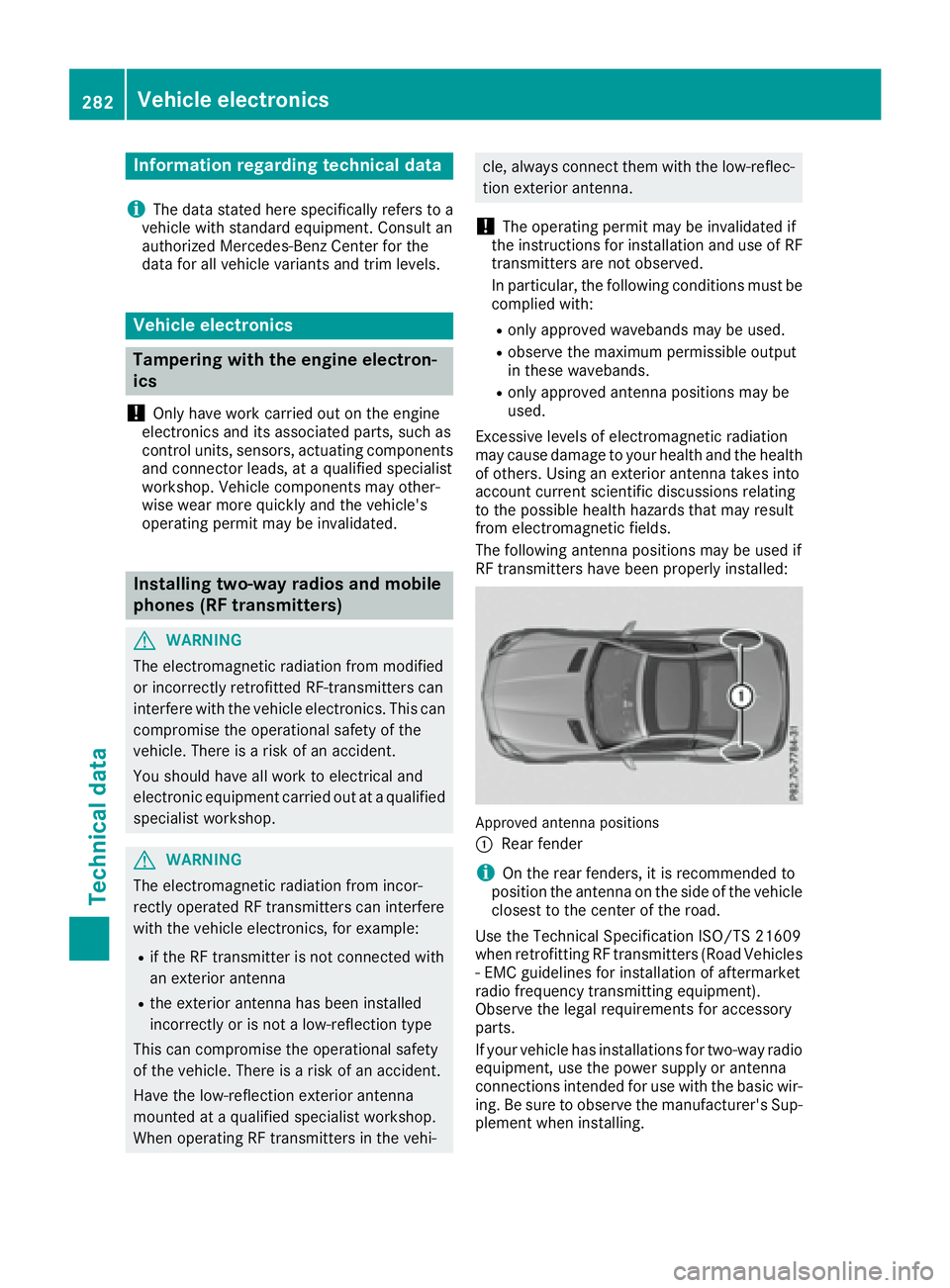
Information regardin gt echnica ld at a
i The dat as ta te dh er es pecifically refers to a
vehicl ew it hs ta ndard equipment. Consult an
authorize dM ercedes-Ben zC ente rf or th e
dat af or all vehicl ev ariants and trim levels.
Vehicle electronics
Tampering with th ee ngin ee lectron-
ics
! Only hav ew or kc arried out on th ee ng in e
electronics and it sa ssociated parts, suc ha s
control units, sensors, actuating component s
and connecto rl eads ,ataq ualified specialist
workshop. Vehicl ec om ponent sm ay other -
wise wear mor eq uickly and th ev ehicle's
operating permit may be invalidated.
Installing two-way radio sa nd mobile
phones (RF transmitters)
G WARNIN G
The electromagneti cr adiation from modifie d
or incorrectl yr etrofitte dR F-transmitters can
interfere wit ht he vehicl ee lectronics .T his can
compromise th eo perational safet yoft he
vehicle. Ther eisar is kofana ccident.
You should hav ea ll wor ktoe lectrical and
electronic equipmen tc arried out at aq ualified
specialist workshop.
G WARNIN G
The electromagneti cr adiation from incor-
rectl yo perate dRFt ra nsmitters can interfere
wit ht he vehicl ee lectronics ,f or example:R
if th eRFt ra nsmitte risn ot connecte dw it h
an exterio ra ntennaR
th ee xter io ra ntenna has been installed
incorrectl yorisn ot al ow-reflection typ e
This can compromise th eo perational safet y
of th ev ehicle. Ther eisar is kofana ccident.
Hav et he low-reflection exterio ra ntenna
mounte dataq ualified specialist workshop.
When operating RF transmitters in th ev ehi- cle ,a lways connec tt he mw it ht he low-reflec -
tion exterio ra ntenna.
! The operating permit may be invalidated if
th ei nstruction sf or installation and use of RF
transmitters are no to bserved.
In particular, th ef ollowin gc onditi on sm ust be
complied with: R
only approve dw avebands may be used. R
observ et he maximum permissible output
in these wavebands. R
only approve da ntenna position sm ay be
used.
Excessiv el evels of electromagneti cr adiation
may caus ed amag etoy our healt ha nd th eh ealt h
of others. Using an exterio ra ntenna takes int o
accoun tc urren ts ci entific discussion sr elating
to th ep ossible healt hh azards that may result
from electromagneti cf ields.
The followin ga ntenna position sm ay be used if
RF transmitters hav eb een properly installed:
Approved antenna position s
�C
Rear fender
i On th er ear fenders, it is recommended to
position th ea ntenna on th es ide of th ev ehicl e
closes ttot he center of th er oad .
Use th eT echnical Specification ISO/TS 2160 9
when retrofitting RF transmitters (Road Vehicles
-E MC guidelines for installation of aftermarket
radi of re quency transmitting equipment) .
Observ et he legal requirements for accessory
parts.
If your vehicl eh as installation sf or two-way radi o
equipment, use th ep ower suppl yora ntenna
connection si ntended for use wit ht he basic wir-
ing .Bes ur etoo bserv et he manufacturer' sS up -
plemen tw hen installing.282
Vehicle electronics
Technical data
Page 287 of 294
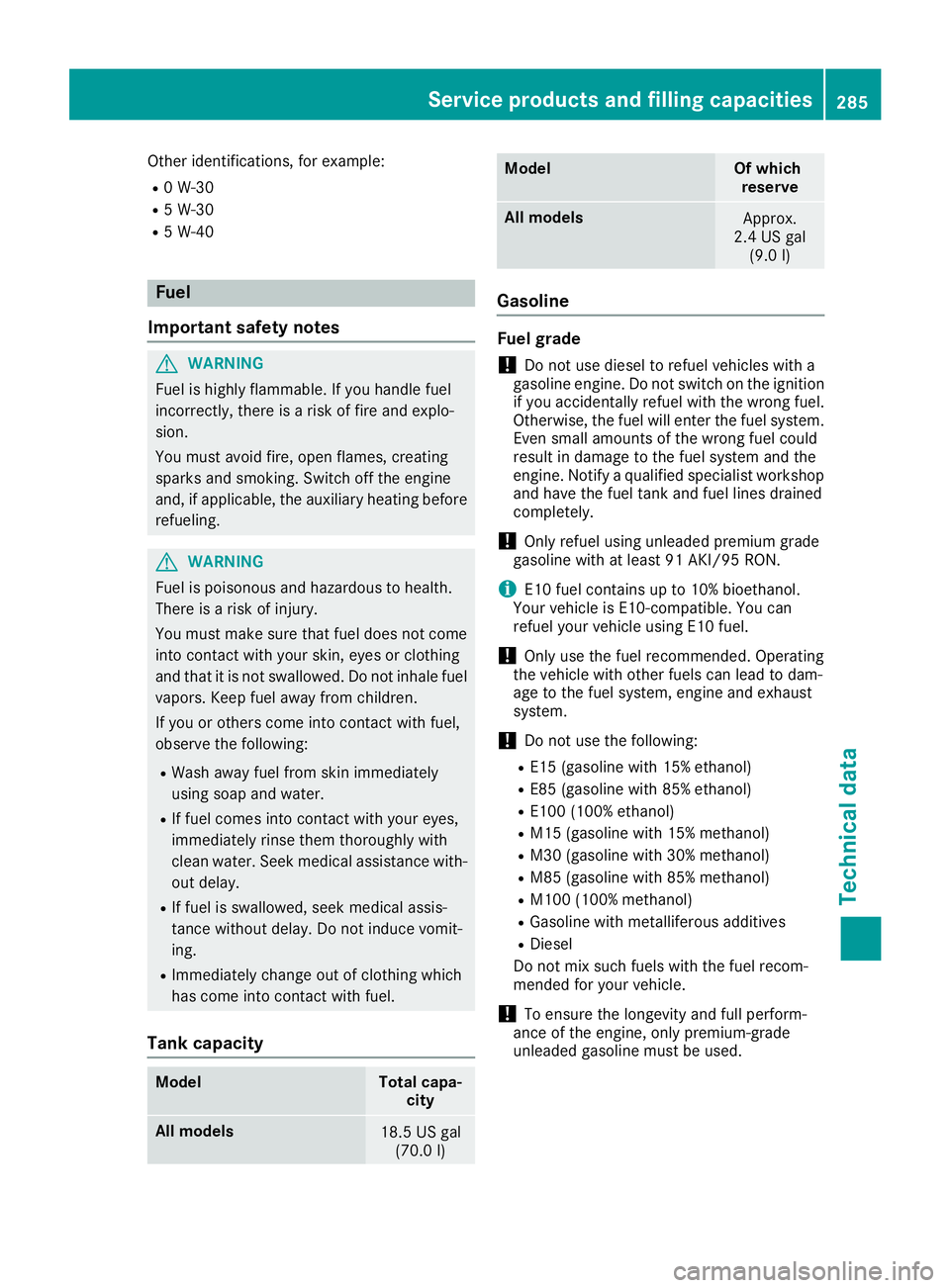
Other identifications, for example: R
0W -30R
5W -30R
5W -40
Fuel
Important safety notes
G WARNING
Fuel is highly flammable. If you handle fuel
incorrectly, there is ar isk of fire and explo-
sion.
You must avoid fire, open flames, creating
sparks and smoking. Switch off the engine
and, if applicable, the auxiliary heating before
refueling.
G WARNING
Fuel is poisonous and hazardous to health.
There is ar isk of injury.
You must make sure that fuel does not come
into contact with your skin, eyes or clothing
and that it is not swallowed. Do not inhale fuel
vapors. Keep fuel awa yf rom children.
If you or others come into contact with fuel,
observe the following: R
Wash awa yf uel from skin immediately
using soap and water. R
If fuel comes into contact with your eyes,
immediately rinse them thoroughly with
clean water. Seek medical assistance with-
out delay. R
If fuel is swallowed, seek medical assis-
tance without delay .Don ot induce vomit-
ing. R
Immediately change out of clothing which
has come into contact with fuel.
Tank capacity
Model Total capa-
city
All models
18.5 US gal
(70.0 l) Model Of which
reserve
All models
Approx.
2.4 US gal
(9.0 l)
Gasoline Fuel grade
! Do not use diesel to refue lv ehicles with a
gasoline engine. Do not switch on the ignition
if you accidentally refue lw ith the wrong fuel.
Otherwise, the fuel wil le nter the fuel system.
Even smal la mounts of the wrong fuel could
resul tind amage to the fuel system and the
engine. Notify aq ualified specialist workshop
and have the fuel tank and fuel lines drained
completely.
! Only refue lu sing unleaded premium grade
gasoline with at least 91 AKI/95 RON.
i E10 fuel contains up to 10% bioethanol.
You rv ehicl eisE 10-compatible. You can
refue ly ou rv ehicl eu sing E10 fuel.
! Only use the fuel recommended. Operating
the vehicl ew ith other fuel sc an lea dtod am-
age to the fuel system, engine and exhaust
system.
! Do not use the following: R
E15 (gasoline with 15% ethanol) R
E85 (gasoline with 85% ethanol) R
E100 (1 00% ethanol) R
M15 (gasoline with 15% methanol) R
M30 (gasoline with 30% methanol) R
M85 (gasoline with 85% methanol) R
M100 (1 00% methanol) R
Gasoline with metalliferous additives R
Diesel
Do not mix such fuel sw ith the fuel recom-
mended for you rv ehicle.
! To ensure the longevity and ful lp erform-
ance of the engine, only premium-grade
unleade dg asoline must be used.Service products and fillin gc apacities 285
Technical data Z
Page 288 of 294
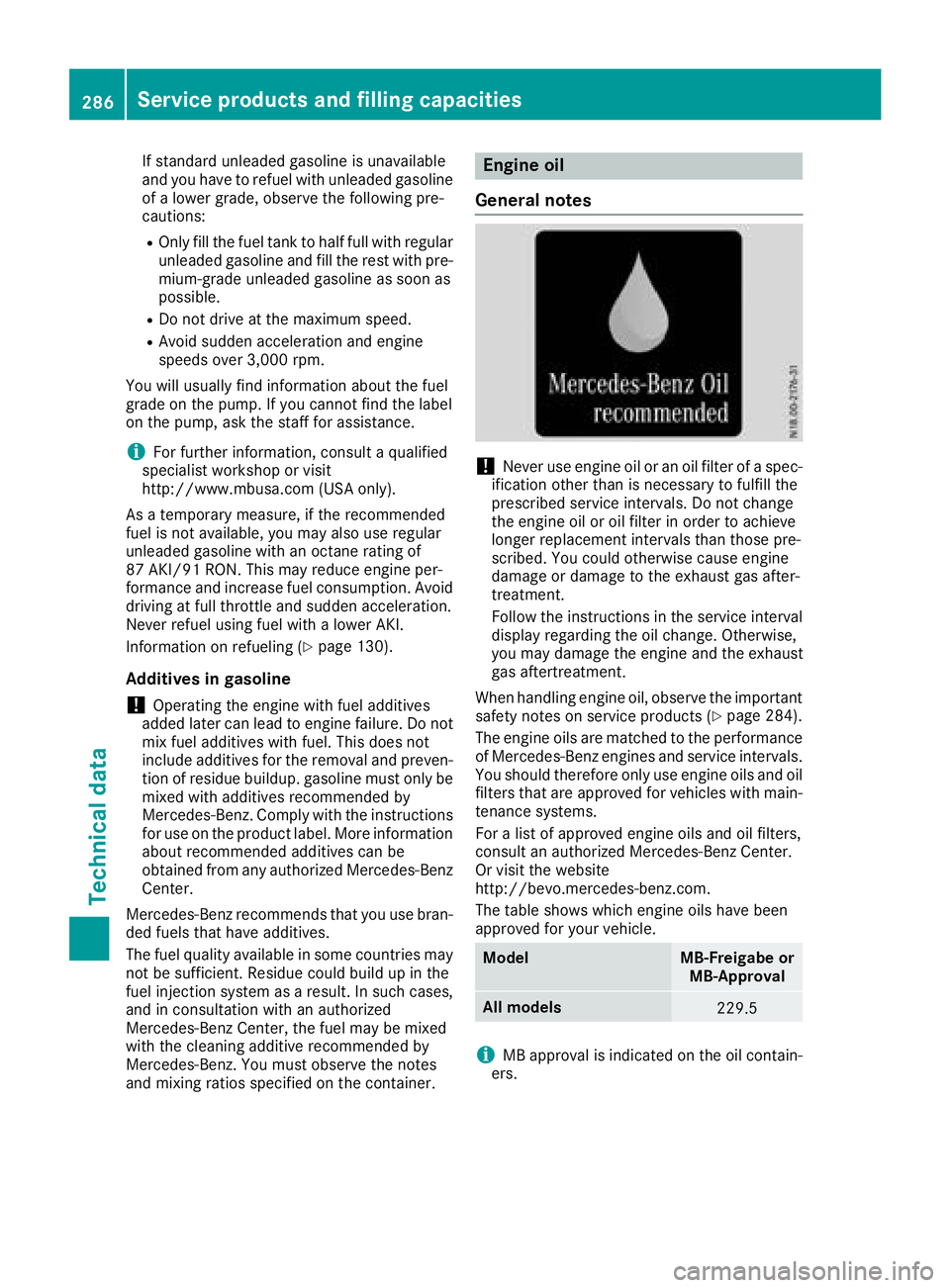
If standard unleaded gasoline is unavailable
and you have to refuel with unleaded gasoline
of al owe rg rade ,o bserve the following pre-
cautions: R
Only fill the fuel tank to half full with regular
unleaded gasoline and fill the rest with pre-
mium-grade unleaded gasoline as soon as
possible. R
Do not drive at the maximum speed. R
Avoid sudden acceleration and engine
speed so ver 3,000 rpm.
You wil lu suall yf ind information abou tt he fuel
grade on the pump. If you cannot find the label
on the pump, ask the staff for assistance.
i For further information, consult aq ualified
specialist workshop or visit
http://www.mbusa.com (USA only).
As at emporary measure, if the recommended
fuel is not available, you may also use regular
unleaded gasoline with an octane rating of
87 AKI/91 RON. This may reduce engine per-
formance and increase fuel consumption. Avoid
driving at full throttle and sudden acceleration.
Never refuel using fuel with al owe rA KI.
Information on refueling ( Y
page 130).
Additives in gasoline
! Operating the engine with fuel additives
adde dl ater can lea dtoe ngine failure. Do not
mix fuel additives with fuel. This does not
include additives for the removal and preven-
tion of residu eb uildup. gasoline must only be
mixed with additives recommended by
Mercedes-Benz. Compl yw ith the instructions
for use on the product label. More information
abou tr ecommended additives can be
obtained from any authorized Mercedes-Benz
Center.
Mercedes-Benz recommends that you use bran-
ded fuels that have additives.
The fuel quality available in some countries may
not be sufficient. Residue could build up in the
fuel injection system as ar esult. In such cases,
and in consultation with an authorized
Mercedes-Benz Center, the fuel may be mixed
with the cleaning additive recommended by
Mercedes-Benz. You must observe the notes
and mixing ratios specifie dont he container. Engine oil
General notes
! Never use engine oil or an oil filter of as pec-
ificatio no ther than is necessary to fulfill the
prescribe ds ervice intervals. Do not change
the engine oil or oil filter in order to achieve
longer replacement intervals than those pre-
scribed. You could otherwise cause engine
damage or damage to the exhaust gas after-
treatment.
Follow the instructions in the service interval
display regarding the oil change. Otherwise,
you may damage the engine and the exhaust
gas aftertreatment.
When handling engine oil, observe the important
safety notes on service products ( Y
page 284).
The engine oils are matched to the performance
of Mercedes-Benz engines and service intervals.
You shoul dt herefore only use engine oils and oil
filters that are approved for vehicle sw ith main-
tenance systems.
For al ist of approved engine oils and oil filters,
consult an authorized Mercedes-Benz Center.
Or visit the website
http://bevo.mercedes-benz.com.
The table shows which engine oils have been
approved for you rv ehicle.
Model MB-Freigabe or
MB-Approval
All models
229.5
i MB approval is indicated on the oil contain-
ers.286
Servic ep roducts and filling capacities
Technical data